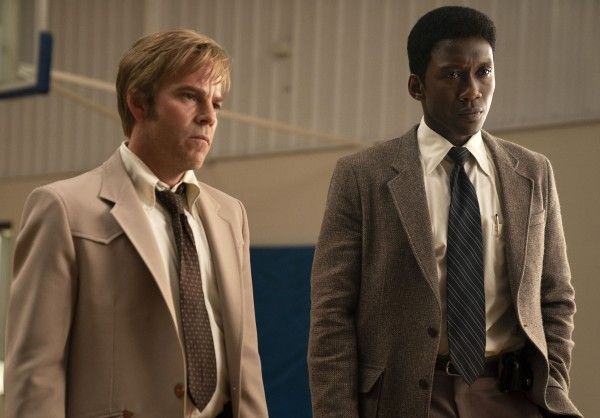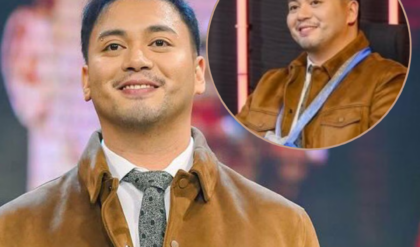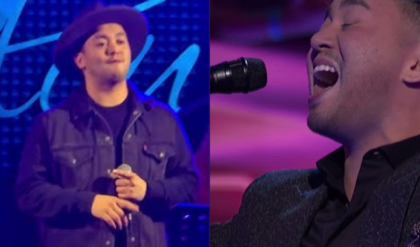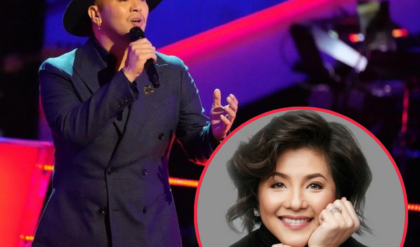Spoilers for True Detective Season 3 Episode 7 follow below.
Well that was something. The penultimate episode of True Detective dropped a couple of major revelations, then ended with a tremendous cliffhanger teeing up a confrontational—and exciting—finale that will hopefully provide some closure for Mahershala Ali’s Detective Wayne Hays, who along with his partner Roland (Stephen Dorff), been haunted by a murder investigation in three separate timelines for the bulk of the HBO drama’s third season.
To dig into the specifics of the seventh episode and to tease a bit of the finale, I got the chance to speak with director Daniel Sackheim, who helmed episodes 3, 6, 7, and 8 of the season. He broke down that cliffhanger ending, shooting the big interrogation scene with Harris, how he juggled all the major revelations, and what fans can expect in the finale—which he calls one of the most satisfying finales he’s ever been a part of. We also discussed the third season as a whole, for which Sackheim came in a little late as a replacement for director Jeremy Saulnier. He spoke about how taking over for Saulnier, his vision for the season that ultimately won him the job, the challenging process of shooting the entire season at once (instead of episode-by-episode), collaborating with showrunner Nic Pizzolatto, and working with such a stacked cast.
It’s a revealing and fascinating conversation with a director whose diverse resume ranges from The Leftovers to The Americans to Game of Thrones, and in speaking with him it became clear very quickly that not only is Sackheim a director with a specific and character-driven vision, but also one who delights in finding himself inspired by the material and cast he’s working with. It was a joy to dig deep into this very good season of True Detective, and what he had to say about the finale has me dying to see how it all concludes.
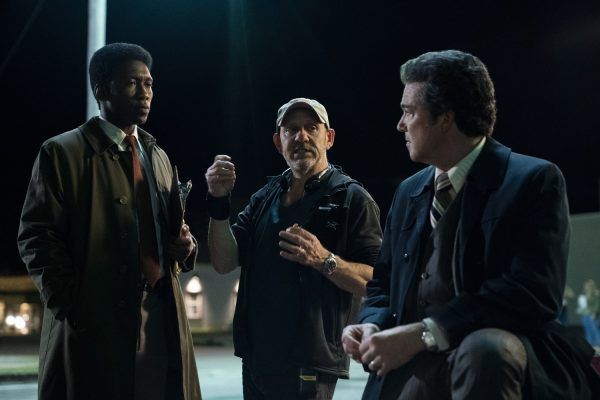
Check out the full interview below, and be aware there are spoilers up through Episode 7 of True Detective’s third season.
First thing’s first: You get to set up what appears to be our big bad at the end of this episode, with Michael Rooker credited as the voice on the phone with Wayne. What was your reaction when you read that in the script, and how did you go about executing that sequence, because it’s really tense?
DANIEL SACKHEIM: When I took the job, I read seven scripts. Episode 8 was a work in progress for a very long time. For the longest time, I never really knew what happened in 8, to be honest, because it was a work in progress. If you can imagine, I was like any other member of the audience sitting there wondering what the fuck is going to happen? Every time I would ask Nic [Pizzolatto], the answer would be, “I don’t want to spoil it for you. Wait till you read the script.” But it’s a fantastic cliffhanger, for sure. Very suspenseful. I guess I was really excited at the prospect of what was going to unfold.
Well, this episode in particular fills in a lot of gaps. We now know that Roland and Wayne killed Harris in 1990 and covered it up, which explains why Wayne was cagey about his disappearance. We also learn about Miss Isabella, which sounds like a pretty big piece of the puzzle. When you have so much new information to present to the viewer in an episode like this, how do you approach these multiple reveal scenes, so they each have their own significant impact as major revelations?
SACKHEIM: Wow, that’s a fantastic question. I don’t know that anyone’s ever asked me that quite that way. Well, I think the idea is that you want to try to continue, as much as you can, to tease out the reveal throughout the story, right? So, within the body of the scene itself, as well as how you resolve that, to how you end the scene. What’s the moment that you end on? That’s both an issue of narrative in terms of what Nic has written, and how I shoot it, and how we edit it. Some of those decisions also get made in editing. So if you feel like you might be giving too much away, we’ll pull back from there. It’s always, I think, the idea of keeping the audience hanging a little bit, and keep them leaning in. You always want to leave them wanting more. I guess the idea is that I like to try to be stingy.
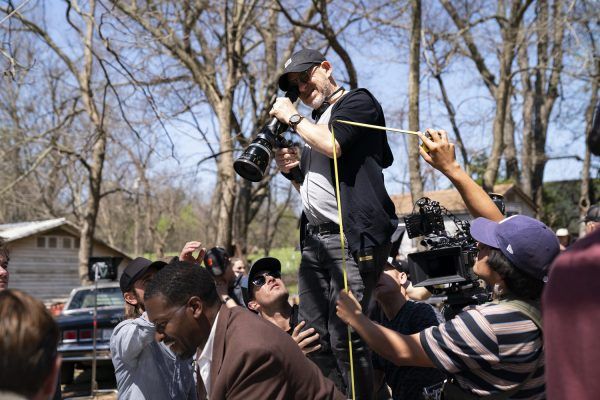
Well, I mean, along those lines, I feel like, in many ways, the centerpiece of this episode is the Harris interrogation that goes sideways, if you can call it an interrogation. It’s a really great, moody, noir-ish scene. I really love the lighting and the cinematography in that sequence as well. I was wondering if you could just talk about shooting that sequence, and setting that scene up, because you are revealing a major piece of the back story here.
SACKHEIM: Unless I’m mistaken, I feel like that was out of a 100-day shooting schedule, I feel like that was the third to the last or second to last day. It was done for a number of reasons that way. Partly, it was that Nic and I worked in teams that’d work on the scene for a long time. So it was sort of going back and forth through an editing process. But also, part of it was that we really wanted to maintain, in the actors’ minds, what was going to happen. So that even for everyone, it was still a little bit of a mystery, even though they had read the scripts, and they knew the content of the scenes. As opposed to them sort of inadvertently giving away too much, even with a simple gesture in a scene that might have been shot, like, months before. So it was a little bit of a trick.
With respect to the scene itself, it was pretty emotional and visceral, actually. They’re all wonderful actors and immensely professional, and whenever you do anything that involves those kind of stunts, where someone could get seriously hurt, everyone is always very cautious. But it was so wonderful to see how they kind of let that narrative take over their lives. Because they had lived so much of the series prior to that, had lived so much of this mystery, including that very powerful scene that Nic shot in one of his episodes where, as old men—I think it was the end of Episode 5 there—sort of talking about that moment.
It actually made the shooting of the scene so much more powerful, and gave it so much more gravitas. Because now they were finally getting a chance to live through that moment that had always been a little bit of a mystery. Again, I mean, it isn’t that they didn’t know what the substance of what had happened was, but it was always that we wanted it to sort of hang there, in their heads, as ill-defined. Or a little amorphous. And that hopefully was communicated, in terms of what the audience is getting to learn.
You mentioned this was the third to last day of shooting. I’m just curious, from a production standpoint, was the season crossboarded where you shot everything out of order, or were you shooting episode by episode?
SACKHEIM: It was crossboarded.
Oh, okay. Wow.
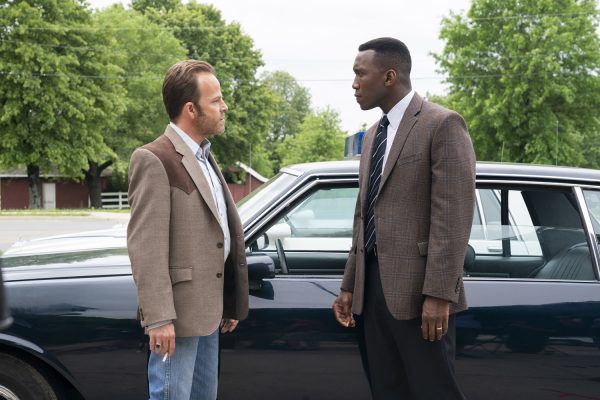
SACKHEIM: And in addition to being crossboarded, at any given time, you would be working in any combination of timelines. Most of the sequences that involved them as old men, those were sort of modular. They would be shot together, because it was four and a half hours to put on that makeup. And so it wasn’t practical from a production standpoint, in terms of how it would affect the shooting hours, let alone the wear and tear on the actors to do that all the time.
But because we were constantly sort of flipping back and forth, not only in terms of episodes, but in terms of timelines, it was challenging. And I created a visual reference, almost like a hierarchical board that would you see in a crime show, when they’re talking about a mob family. It would start with 1980, and 1990, and 2015. So it was kind of this visual reference that we would always go back to and say, “Well, you were here, and now you’re going here.” It’s the only way to kind of keep it straight in our heads, let alone sort of help them track where their emotional throughlines were, where the characters were, at any given point.
That was going to be one of my questions, because not only are you working in three separate timelines, but you also have a protagonist who, in 2015 his mental capacity is blurring the timelines. So you could go one of two ways. You could visually distinguish each timeline, or they could bleed into each other, because the protagonist in 2015 is remembering things differently. What was your approach there, and did that present an exciting challenge to you?
SACKHEIM: I think we were all on the same page, in terms of trying to give each timeline its own sort of distinctive quality. For example, if you look at the style of 1980, and the color palette to it, it has sort of this golden cyan quality to it that’s almost like an old ektachrome slide. I mean, the intention was to give a subtle archival quality to it. Which isn’t present at all in the 2015 timeline, which is given sort of a much more straight ahead visual approach. However, the thing that made that challenging and interesting to do was that, any time you got really deeply into his head, especially when he’s having these kind of dementia-induced hallucinations, that’s where I could stretch my visual storytelling muscles.
And then there, the challenge was how do we tell this part of the story, and what he’s going through, and firmly ensconce the audience in Wayne’s head? Make us really feel like we’re seeing the world through his eyes, versus just to do something that was perhaps visually arresting, but didn’t tell the story, in terms of his own struggle and his fear, what he’s going through. Because as he’s experiencing this, and it’s out of his control, he’s sort of both lost and terrified as this old man who’s now lost in his inability to sort of control his own thoughts.
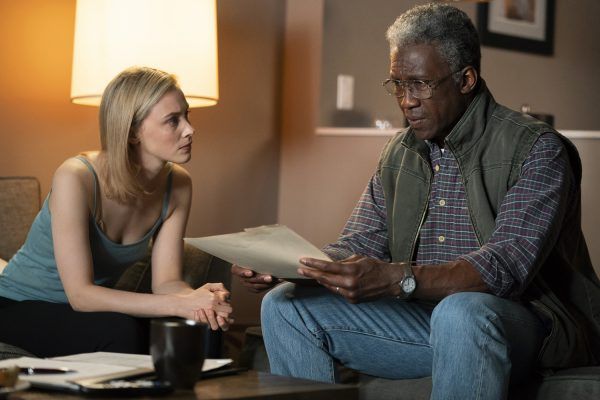
I’d be remiss if I didn’t ask about the other big surprise in Episode 7, which is the allusion to Rust and Marty’s investigation from Season 1, which I guess confirms that these two seasons take place in the same universe. That was really fun for me, just as a fan of the show. What was your reaction reading that, and did you have many discussions with Nic about it?
SACKHEIM: Well, I can say that there was a lot of discussion about it. I think it’s important to understand the context in which that reveal was made, which is that it was being brought forward by this kind of documentary filmmaker who’s doing a true crime TV series. So, there is a bit of conjecture on her part, and there might be validity to this, or there might not. So the audience will find out whether that’s true or not. But I do want to keep it in its proper context.
Sure, sure. So was there debate over whether to include that kind of connection at all? Or was it just over connecting into this case?
SACKHEIM: No, there was never a debate about it. I mean, obviously there’s certainly a resemblance between the dolls that do appear in this season and the dolls that appeared in Season 1. But how that connection works out, I can’t really say. You’re just going to have to wait to see. It will become really clear what the connection is, if any, in the finale. But I wouldn’t want to spoil it for anyone beyond that.
I know you came into this series kind of late, as Jeremy Saulnier was initially poised to direct most of the season. So when you came in, did you kind of pick up where he left off, or look at his work on the first two episodes? What was that experience like?
SACKHEIM: Look, I adore Jeremy. He’s a lovely man, and a really good director, and I thought he did a capital job on the show. It was simply that he had been shooting for, I don’t know, it was probably a month. There was a discussion, internally, about wanting to shake things up a little bit. So I got seven scripts. I read them, I had about an hour and a half conversation with all the parties, Nic, and David Levine from HBO, and Steve Golin from Anonymous Content, and we talked a little bit about what their intention was, or what they wanted to do, and they asked me for my take on a number of things that they had, that there were storytelling aspects and devices that had not yet been exploited, and really didn’t get heavily exploited in Episode 1 or 2, and that had mostly to do with metaphysical elements of this, in terms of how the series this season plays with time. Using that as kind of the tree through which all these kind of roots come down and sort of permeate all the various episodes.
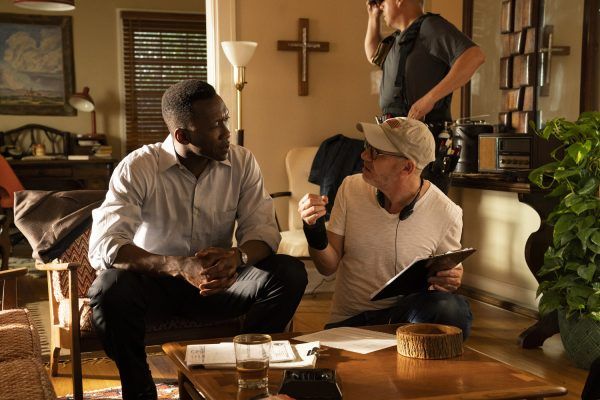
They were asking me how I would approach it, and I, after some thought, talked to them a little bit about how I would approach something. For example, like the sequence that you saw in Episode 7, which is Wayne kind of peering in this void and then he and his 1990 self sort of appearing in the same space and time. I mean, I loved that sequence. It’s one of my favorite sequences. But it was, again, something that I alluded to earlier. It was infusing with a sense of mystery, and trying to be true to the conceit of it being in Wayne’s head.
It’s my contention that this entire story is essentially told from the point of view of Old Wayne, and that every time we see these things, it’s from his perspective. It’s his remembrance of these events. And sometimes his remembrance is accurate, and sometimes it is not. I think those are the building blocks on which the narrative is based. So that by the time you get to Episode 8, if it seems like there are inconsistencies, they are, I think, born out of the fact that his memory is slipping away.
I was going to ask about that sequence, because that was very striking as well, and I understand that, from your perspective as the director, you want to toe this line of getting into his head, but also not maybe making the audience think you’re digging into the supernatural, or things are getting a little weird.
SACKHEIM: I mean, you draw red lines about where you don’t want to go. I’ve done, in my career, a lot of shows about the paranormal, and I didn’t want this to feel like that. I wanted it to feel grounded. Nic and I talked a lot about the need for any of these kinds of sequences to feel grounded in reality. So that, though you might be seeing something that felt weird, or out of this world, or existing outside the temporal bounds of this world, there was a logic to it. There was a visual logic that went to it. Maybe I pressed the bounds on that sequence. I’m not sure. But I really do love it, and I love the sort of mystery that it presents. I feel like it’s a seminal moment within this season, in that is the one time where we really see both of old Wayne and young Wayne sort of coexisting in his mind.
I wanted to ask you about the performances. This cast is incredible. Obviously, Mahershala and Stephen, but also Carmen and Scoot. I mean, that interrogation scene in Episode 6 with Scoot McNairy just blew me away. What’s it like for you, as the director, to have a front row seat to these very intimate and very emotional performances?
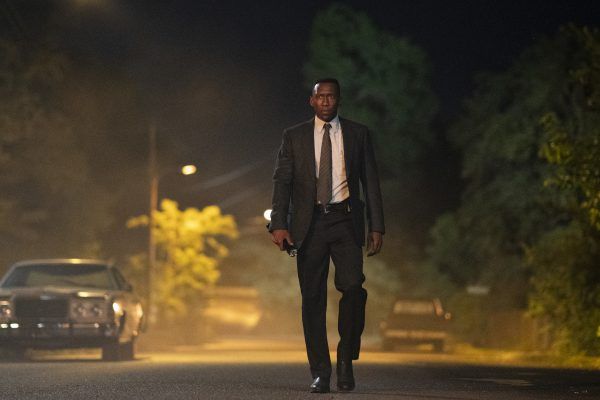
SACKHEIM: Oh, are you kidding? It’s a gift. This was a gift, getting to work on this show that I have been a huge fan of, since Season 1, and of Nic’s writing, which I’ve been a huge fan of, and to work with an actor of the caliber of Mahershala Ali, let alone the kind of man, the kind of gentleman he is. I cannot say good enough things about it. And I really feel like everybody rose to the occasion. I think this is some of Stephen Dorff’s best work.
Oh, I agree. People are calling it “The Dorffaissance”.
SACKHEIM: I really think so too. I mean, I really think he hit a home run. I think he really crushed it. Scoot, I’ve been a huge fan of since really kind of discovering him in Godless. And a fan of Carmen, who I really discoveredin The Girlfriend Experience, in Season 2. Which, if you haven’t seen, you really should. Because I’ve always liked her, but I think some of her TV work is actually some of her most impressive work. And I think the reason for that is that television still, with the exception of movies like The Favourite, is where women really get to play these more fully dimensional roles.
Yeah. I agree with that. The writing and the performances this season, I think, have been really, really terrific.
SACKHEIM: And Nic’s done a wonderful job. Very impressive.
Definitely. I did also want to ask about the experience of shooting in Arkansas, which is a place where a lot of these big productions don’t really shoot. It’s not Atlanta, it’s not LA, it’s not Vancouver. What was that experience like for you? What did it bring to the season?
SACKHEIM: So the reason behind Arkansas, and why the story was set there, is that Nic was in graduate school there, at the University of Arkansas. So it’s kind of near and dear to his heart. The people there are lovely. Even though it’s a college town, it’s a small town. I’m not sure it is specifically indicative of, culturally or politically, Arkansas on a whole. I mean, it’s probably one of the more liberal parts of Arkansas. But the people were very nice, and they were very welcoming. I think, in many ways, it was this strong push for verisimilitude in the piece. To actually shoot it in the place where it was written for, versus, say, shooting in Georgia, for Arkansas. Both HBO and Nic were real strong supporters of feeling rooted in a place that the story was written for. I mean, I liked it. There are challenges to it, for sure. There are no crews there, and as welcoming as the Film Commission was, most everyone had to be brought in from other places, so it was a big challenge for the producers to put it together. Scott Stephens did a phenomenal job in orchestrating that. I don’t know how he did it. It’s like magic. But it was a great experience that the crew was all together, and we probably bonded, I think, more than most because we were all kind of orphans there.
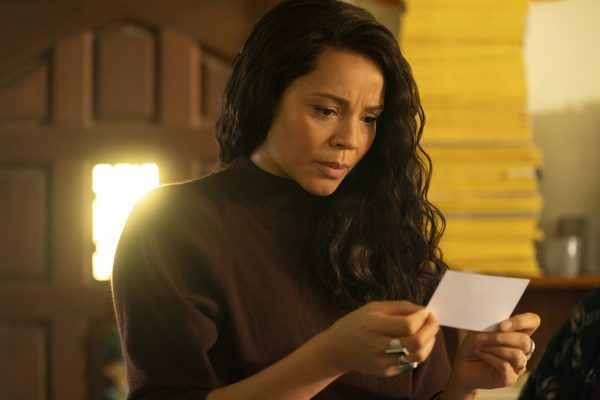
No spoilers, but going into the finale, what can you tease viewers about next week’s episode? And how did you feel about your time on True Detective as a whole?
SACKHEIM: Oh, if I could I would certainly do it all again, in another season. It was great. I really enjoyed it. I mean, it was hard. It was challenging, because I was brought in late in the game, and there was sort of a lot to do, and very little time to prep it. But it was certainly rewarding from the standpoint of working on good material, and working with great talent, and working with some really, really talented artists, like Germaine McMicking, who was the cinematographer. And that’s just been one example.
I’d say that I think the finale is going to be emotionally powerful. Heartbreaking. But I would hope the audience would find it satisfying, not only from the standpoint of the resolution of the overarching mystery, but emotionally satisfying as well. Especially in terms of the culmination of the characters’ journeys. I know that may sound maybe overly pedantic or vague, but I think, once you see it, you’ll see what I mean. It is both emotionally crippling to watch at times, but it also really soars towards the end, and I think it’s a really satisfying experience. It’s one of the most satisfying finales that I’ve been involved with, and I’ve shot a bunch in my past.
The Season 3 finale of True Detective airs Sunday, February 24th.
